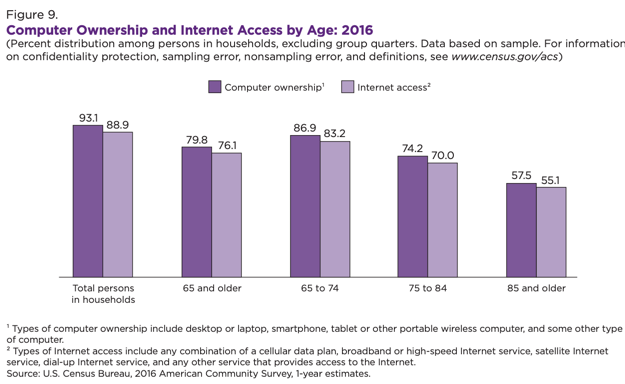Reference: U.S. Census: The Population 65 Years and Older in the United States: 2016
From the U.S. Census:
The [Population 65 Years and Older in the United States: 2016]] report provides a look at selected demographic, social, housing and economic characteristics of the 65 years and older population in the United States based on 2016 American Community Survey (ACS) one-year data. The report also draws comparisons between people ages 65 to 74, 75 to 84, and 85 and older. The information includes population size, marital status, living arrangements, caregiving for co-resident grandchildren, English ability, language spoken, educational attainment, computer ownership, internet access, homeownership, disability, labor force participation, occupation, median earnings, income type and poverty status.
From the
Lower fertility and increased longevity have led to the rapid growth of the older population across the world and in the United States. In 2015, among the 7.3 billion people estimated worldwide, 617.1 million (9 percent) were aged 65 and older. By 2030, the older population will be about 1 billion (12 percent of the projected total world population) and by 2050, 1.6 billion (17 percent) of the total population of 9.4 billion will be 65 and older. This rapid growth of the older population contrasts with an almost flat youth population (under age 20) and moderate increase in the workingage (aged 20 to 64) population projected over the same period.
The older population is also growing across world regions, including Africa, Asia, Europe, Latin America and the Caribbean, Northern America, and Oceania, although at varying levels. Europe is currently the oldest region, with 17.4 percent of the total population aged 65 and older in 2015; by 2050, the older population will make up more than a quarter of Europe’s total population. The older population in Asia and Latin America and the Caribbean will grow the fastest of all regions, with Asia’s older population almost tripling in size from 341.4 million in 2015 to 975.3 million in 2050. Because of high fertility rates leading to a young age structure, population projections indicate that Africa will remain relatively younger than the other regions—even while the older African population nearly quadruples from 40.6 million in 2015 to 150.5 million in 2050. The population of Northern America, which includes the United States, is also continuing to age and, according to projections, will retain
its position as the second oldest region in the world in 2050 with 21.4 percent of the total population 65 and older.
The U.S. older population grew rapidly for most of the 20th century, from 3.1 million in 1900 to 35.0 million in 2000. Except during the 1990s, when the relatively smaller Depression Era cohort of the 1930s reached the age of 65, the growth of the population 65 and older surpassed that of the total population and the population under the age of 65.3 The United States will experience further expansion of the older population for many decades to come, fueled by the baby boom cohort that began turning 65 years old in 2011.
Direct to Full Text Report
25 pages; PDF.
See Also: Interactive Data Map and Other Visualizations: U.S. Population 65 and Older
Filed under: Data Files, News
About Gary Price
Gary Price (gprice@gmail.com) is a librarian, writer, consultant, and frequent conference speaker based in the Washington D.C. metro area. He earned his MLIS degree from Wayne State University in Detroit. Price has won several awards including the SLA Innovations in Technology Award and Alumnus of the Year from the Wayne St. University Library and Information Science Program. From 2006-2009 he was Director of Online Information Services at Ask.com.



